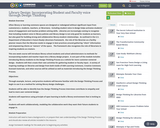
Often library or learning commons spaces are designed or redesigned without significant input from customers(i.e. students, teachers, or librarians). Including student voice in design helps activates students' sense of engagement and teaches problem solving skills. Libraries are increasingly coming to recognize that including student voice in library policies and library design is not only good for students as learners, but also good for building strong and collaborative library-student relationships. As outlined in the U.S. Department of Education's Future Ready Librarians framework, the role of the librarian as a facility planner means that the librarian needs to engage in best practices around gathering "client" information and empowering clients as "owners" of the space. The framework also recognizes the role of librarians in inspiring students as creators. This one week course will introduce library school students and school administrators to methods for incorporating student and teacher input into a library design project. A core part of the module includes introducing library students to the Design Thinking Process as a vehicle for more customer-centered design. Students will then create their own activities for gathering student or faculty input. A variety of inspiring readings on libraries and design from both inside of OER Learning Commons, Creative Commons licensed materials, and other sources will be utilized as well as materials introducing the Design Thinking Process. Objectives:Through example, lecture, and practice students will become familiar with the Design Thinking Process and begin to use it as a method for solving library design challenges.Students will be able to identify how the Design Thinking Process interviews contribute to empathy and lead to more user centered design.Students will experience using principle of open learning to build a library environment that is inviting to all.Students will work collaboratively, modeling the collaborative work they want their future students to engage in.
- Subject:
- Higher Education
- Information Science
- Material Type:
- Module
- Author:
- Carolyn Foote
- Date Added:
- 09/17/2016
